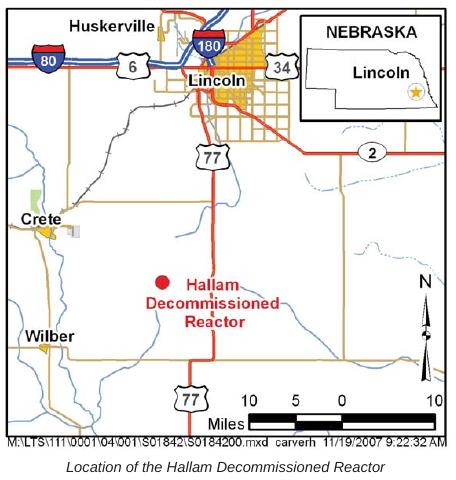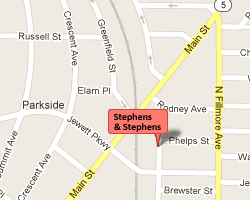Hallam Sodium Graphite Reactor
Home / Areas of Practice / Energy Employees Occupational Illness Compensation Program Act (EEOICPA) / EEOICP: Facility List / Hallam Sodium Graphite Reactor
Also Known As: Hallam Nuclear Power Facility, HNPF, Nebraska Hallam Nuclear Power Facility
State: Nebraska
Location: Hallam
Time Period: 1960-1971
Facility Type: Department of Energy
Facility Description
The Atomic Energy Commission (AEC) built and operated the Hallam Nuclear Power Facility in the 1960s. When the AEC retired this facility in 1971, the reactor core and most other radioactive materials were removed from the site; some radioactive materials were entombed in place. The Hallam facility, now owned by the Nebraska Public Power District, has no current mission.
Listing
Hallam Sodium Graphite Reactor is listed as an Atomic Weapons Employer (AWE) site and as a Department of Energy (DOE) site under the EEOICPA.
Compensation
As of 04/05/2015, the total compensation paid under Parts B and E of the EEOICPA, including medical compensation, for workers suffering from the effects of having worked at Hallam Sodium Graphite Reactor is $1,034,953.
Hallam Sodium Graphite Reactor Workers
If you or your parent worked at this or any other AWE facility and became ill, you may be entitled to compensation of up to $400K plus medical benefits from the US Department of Labor. Call EEOICPA Counsel Hugh Stephens at 1-855-EEOICPA (336-4272) or fill out the form to the right, whether or not you have already filed a claim and even if your claim has been accepted or denied.
We can help with all OWCP (Federal Workers Compensation) claims, impairments, wage loss and health care. 2495 Main Street, Suite 442 Buffalo, NY 14214.
Site Description and History
The Hallam decommissioned reactor site is in southeastern Nebraska, approximately 19 miles south of Lincoln. The 18-acre site is located on the 640-acre Sheldon Power Station, a coal-fired power plant owned and operated by the Nebraska Public Power District. The original nuclear power facility was a 240-megawatt (thermal), sodium-cooled, graphite-moderated, nuclear reactor. The U.S. Atomic Energy Commission (AEC), a predecessor agency of the U.S. Department of Energy (DOE), operated the reactor from 1962 to 1964 as part of AEC’s Power Demonstration Program. Objectives for the reactor were fulfilled by 1966, and the Nebraska Public Power District decommissioned and dismantled the facility between 1967 and 1969.
Facility Decommissioning
The reactor facility operated in a massive, reinforced concrete building. Except for the concrete structure that housed the intermediate heat exchanger, the aboveground portion of the facility was demolished during decommissioning, and all aboveground components of the reactor were removed and decontaminated or disposed of. All bulk sodium and most of the belowground radioactive materials were removed from the site, while some radioactive materials were entombed in place. Steam was used to deactivate residual sodium to prevent hydrogen from forming if water were to enter the structure.
Contaminants remaining at the site are contained in three areas of the belowground portion of the reactor building: Area 1 (reactor vessel and vessel containment structures), Area 2 (Fuel Storage Pit 3 thimbles), and Area 3 (moderator element storage cells). Each of these areas is steel lined and surrounded by several feet of concrete and other structural materials, which provided shielding when the facility was operating. Activation products—materials that were formerly stable but became radioactive after being bombarded with high levels of radioactivity in the reactor core—make up the contamination remaining in these areas. Primary contaminants are cesium-137, cobalt-60, iron-55, manganese-54, nickel-63, samarium-151, strontium-90, and tritium (a radioactive isotope of hydrogen).
Approximately 300,000 curies of radioactive material was entombed at the time of closure. It was calculated that the material would decay to about 15,000 curies by the year 2000. Decay and dose calculations indicate that the decommissioned reactor can be released for unrestricted use around the year 2070.
Access points to the below-grade portion of the facility and the Intermediate Heat Exchanger Building were sealed off using welded steel closures and reinforced expanding concrete. The Intermediate Heat Exchanger Building was coated with a layer of polyvinyl sheeting on all exterior surfaces, then further protected by a concrete cover. The concrete ceiling of the belowground portion of the reactor building was weatherproofed with a sand, polyvinyl membrane, and soil cover. The cover forms a roughly rectangular, 1.4-acre, flat-topped, grass-covered mound with sides sloped to promote runoff.
Documents describing the layout and dimensions of the former reactor building, location of the buried reactor vessel, and detailed engineering information are sealed in stainless steel boxes that are secured in two locations at the site.
Groundwater Monitoring
The regional water table depth at the reactor site is about 150 feet below ground surface, although there are zones of perched groundwater at depths as shallow as 3 feet below ground surface.
In the early 1990s, the Nebraska Department of Health expressed concerns that shallow groundwater at the site could potentially come in contact with radioactive materials buried along the subsurface walls of the former reactor building. DOE conducted soil and groundwater investigations to characterize subsurface conditions at the site. Soil and groundwater samples were scanned for gamma activity and analyzed for gross alpha, gross beta, nickel-63, and tritium. Between 1997 and June 2007, DOE collected groundwater samples annually from 17 monitoring wells. Since 2008, sampling has been conducted once every 2 years. No radioactivity has been detected above background levels in any samples collected to date, and there is no evidence that the reactor facility has had any effect on site soil or groundwater.

Share this:
EEOICPA CLAIMS
If you or your parent worked any of the DOE or AWE facilities listed on this website and became ill, you may be entitled to compensation of up to $400K plus medical benefits from the US Department of Labor.
Call EEOICPA Counsel Hugh Stephens at 1-800-548-4494, email hstephens@stephensstephens.com, or fill out the form below whether or not you have already filed a claim and even if your claim has been accepted or denied.
Contact Us
"*" indicates required fields
*note: Submission of this form does not establish an attorney-client privilege.
Contact Us
Address:
2495 Main Street, Suite 442
Buffalo, New York 14214
Phone:
(716) 852-7590
Fax:
(716) 852-7599
After Hours:
(716) 208-3525
Email Us:
R. William Stephens, Esq.
R. Hugh Stephens, Esq.
Lisa P. Neff, Esq.

